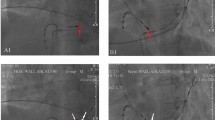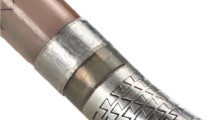Summary
In order to improve the efficacy of modified inferior method or middle method of radiofrequency catheter ablation (RFCA) in the treatment of atrioventricular node reentrant tachycardia (AVNRT), the clinical data of 325 cases of AVNRT from March 1992 to Feb. 2000 being subjected to the treatment of RFCA were retrospectively analyzed. The results showed that the successful rate was increased and recurrence was decreased year by year. In the recent 4 years the effective rate was up to 100%. The complication of three grade of AVB occurred in 3 % and recurrent rate in 9. 1 % before March 1996, but both of them were zero in the last 3 years. The time of RFCA procedure and X-ray exposure was significantly reduced. It was concluded that ablating more than 3 targets by modified inferior method or middle method with energy titrating and strict endpoint was the crux of obtaining satisfactory therapeutic effects and preventing recurrence.
Similar content being viewed by others
References
1994, 2: 11
Yu S L, Zeng Q T, Chen Z Jet al. Treatment of atrioventrichuar node reentrant tachycardia by the method of modified inferior approach of radiofrequency catheter ablation. PACE, 1997, 20(9): 2352
Chen S A, Chiang C E, Tsang W Pet al. Selective radiofrequency catheter ablation of fast and slow pathway in 100 patients with atrioventricular nodal reentrant tachycardia. Am Heart, 1993, 125: 1
Wu D C, Yeh S J, Wang C Cet al. A simple technique for selective radiofrequency ablation of the slow pathway in atrioventricular node reentrant tachycardia. JACC, 1993, 21: 1612
Haissaguerre M L, Shan D C, Jais P R. Slow potential and catheter ablation for AVNRT. Heart, 1997, 78: 1
Stabile G, De Simore A, Somlimene Fet al. The predictive value of junctional beats during the radiofrequency trancatheter ablation of the slow pathway of the nodal reentry circuit. G Ital Cardiol, 1999, 29(5): 549
Li H G, Klein G J, Stites Wet al. Elimination of slow pathway conduction: An accurate indicator of clinical success after radiofrequency atrioventricular node modification. JACC, 1993, 22: 1849
Yu S L, Zeng Q T, Zhang J Met al. Prevention recurrence of atrioventricular node reentrant tachycardia after radiofrequency catheter ablation. J Interventional Cardiology Abstract, 1998, 11(sup): 18A
Author information
Authors and Affiliations
Rights and permissions
About this article
Cite this article
Shilong, Y., Qiutang, Z., Jiaming, Z. et al. Clinical study on the treatment of 325 cases of atrioventricular node reentrant tachycardia by radiofrequency catheter ablation. Current Medical Science 21, 23–25 (2001). https://doi.org/10.1007/BF02888028
Received:
Published:
Issue Date:
DOI: https://doi.org/10.1007/BF02888028




